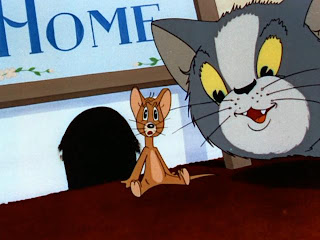Tom (called "Jasper" in his debut appearance) is a blue and white domestic shorthair cat. He is the main protagonist and also the main antagonist of the story, who usually lives a pampered life, although they usually live in several lifestyles, while Jerry is a small brown house mouse who always lives in close proximity to him and is the deuteragonist of the story. "Tom" is a generic name for a male cat (The Warner Bros. cartoon character Sylvester was originally named Thomas). Tom was originally in the very first short, Puss Gets the Boot, and Jerry was seen in the short also, although it was not billed as a Tom and Jerry cartoon. Jerry possesses surprising strength for his size, lifting items such as anvils with relative ease and withstanding considerable impacts with them. Despite the typical cat-eats-mouse scenario, it is surprisingly quite rare for Tom to actually try and consume Jerry. Despite being very energetic and determined, Tom is no match for Jerry's brains and wits. By the final "fade-out" of each cartoon, Jerry usually emerges triumphant, while Tom is shown as the loser. However, other results may be reached; on rare occasions, Tom triumphs, usually when Jerry becomes the aggressor or when he crosses some sort of line (the best example of which occurs in The Million Dollar Cat where, after finding out that Tom's newly acquired wealth will be taken away if he harms any animal, including a mouse, he torments Tom until Tom finally loses his temper and attacks him). Sometimes, usually ironically, they both lose, usually when Jerry's last trap potentially backfires on him after it affects Tom (An example is in Chuck Jones' Filet Meow short where Jerry orders a shark to scare Tom away from eating a goldfish. Afterwards, the shark scares Jerry away as well) or when Jerry overlooks something at the end of the course. Sometimes, they both end up being friends (only for something to happen so that Tom will chase Jerry again). Both characters display sadistic tendencies, in that they are equally likely to take pleasure in tormenting each other. However, depending on the cartoon, whenever one character appears to be in mortal danger (in a dangerous situation or by a third party), the other will develop a conscience and save him. Sometimes, they bond over a mutual sentiment towards an unpleasant experience and their attacking each other is more play than serious attacks. Multiple shorts show the two getting along with minimal difficulty, and they are more than capable of working together when the situation calls for it, usually against a third party who manages to torture and humiliate them both.
Tom changes his love interest many times. The first love interest is Toots who appears in Puss n' Toots, and calls him "Tommy" in The Mouse Comes to Dinner. He is also interested in a cat called Toots in The Zoot Cat although she has a different appearance to the original Toots. The most frequent love interest of Tom's is Toodles Galore, who never has any dialogue in Tom and Jerry cartoons.
Despite five shorts ending with a depiction of Tom's apparent death, his demise is never permanent; he even reads about his own death in a flashback in Jerry's Diary. He appears to die in explosions in Mouse Trouble (after which he is seen in heaven) and in Yankee Doodle Mouse, while in The Two Mouseketeers he is guillotined offscreen.
Despite five shorts ending with a depiction of Tom's apparent death, his demise is never permanent; he even reads about his own death in a flashback in Jerry's Diary. He appears to die in explosions in Mouse Trouble (after which he is seen in heaven) and in Yankee Doodle Mouse, while in The Two Mouseketeers he is guillotined offscree
Jerry Mouse.




No comments:
Post a Comment